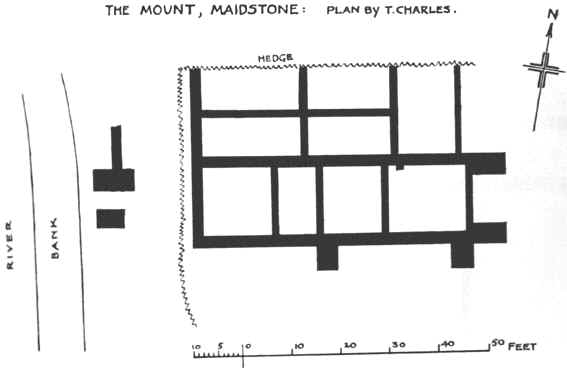Victoria
County History of Kent Vol. 3
1932 - Romano-British
Kent - Towns - Page 99
|
a slight claim to distinction as a spot of
exceptional Convenience where this riverside population may
have been a little more numerous than elsewhere.
Let us glance at the remains of Roman masonry
within the environs of Maidstone: (1) At the Mount, just south
of the Maidstone Barracks and north of the Southern Railway
station (and near Pybus wharf,), a part of the western bank,
25 ft. above the river, fell in 1843 and disclosed Roman
masonry. In an adjacent garden, about 15 ft. from this abrupt
face, remains of walls were then excavated, and were found to
extend northwards into an orchard where they were not
followed. The foundations as exposed extended 65 ft.
from east to west and 35 ft. from north to south. The
walls were of Kentish rag pitched in some cases in
herringbone fashion. In the north-west room of the excavated
area was a pavement of square red tiles, and in an adjoining
room were large masses of ‘rudely ornamented pavement’
made largely of Roman tile. On one side several large piers
abutted upon the house. Much Roman pottery and a coin of
Gordian Ill were found during the work (Journ. Brit. Arch.
Assoc. ii, 86). (2) South-eastwards across the river, near
Upper Stone Street, in a field east of the road to Loose, just
beyond the turning to ‘Tovil and 250 yds. south-east of St.
Philip’s Church, part of a Roman dwelling-house was opened
up in 1870. the 2-ft. walls were of ragstone with tufa quoins. |
|

Fig. 19. Plan of the Villa at the
Mount, Maidstone
|
|
The plan (fig. 20) shows a fragment of a
residence, 160 ft. long so far as excavated. It has a range of
rooms lying north and south and opening on to an eastern
corridor, which is interrupted by a long Projecting room with
an apse at its east end. At the north end of the
excavation part of another room or rooms with an apse cast was
uncovered; this may, as often, mark the original centre of the
range. At the south end of the range was a buttressed
octagonal room with traces of a tessellated pavement and a
channelled hypocaust. Burnt wheat was found in an adjacent
compartment, but is insufficient to indicate the original use
of these rooms.89 Two other hypocausts were
noted in the building. Ill-recorded discoveries of other walls
in the vicinity suggested that the whole structure may have
been of courtyard type ( Arch. Cant. x, 163).
(3) At Combe Farm or West Town, 450 yds. south of
the Railway and just east of Tovil and not far from No. 2,
‘foundations of a Roman ‘villa’ were observed in 1830
and in 1838; the only recorded object was a coin of Florian.
The site does not seen to have been further examined. (Brit.
Arch. Assoc. Journ. ii, 75.) (4) On the West bank of the
Medway, ¼ mile from it, at Little Buckland Farm,
‘foundations of an apparently extensive Roman Villa’ or
‘a species of terrace’ were observed when planting an
orchard about 1835. Nothing more is known of this site, which
lies to the south of Allington. (Arch. Cant. i, 156).
The principal Roman cemetery seems to have lain
to the north-west of Maidstone, not very far from the villa at
the Mount It was found in 1859-60 at Westborough, on the left
bank of the
89 For this room,
cf. the villa at Ashstead (J.R.S. xix, 208, pl. xvi),
Loose, Lockham, Boughton Monchelsea. |
Previous
Page Page 99
Next Page
Back
to Towns page listings
Contents
Page
This website is constructed
by enthusiastic amateurs. Any errors noticed by other researchers will be gratefully received so
that we can amend our pages to give as accurate a record as
possible. Please send details to localhistory@tedconnell.org.uk
|